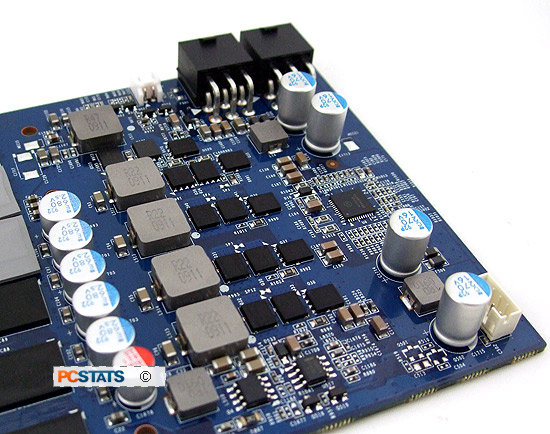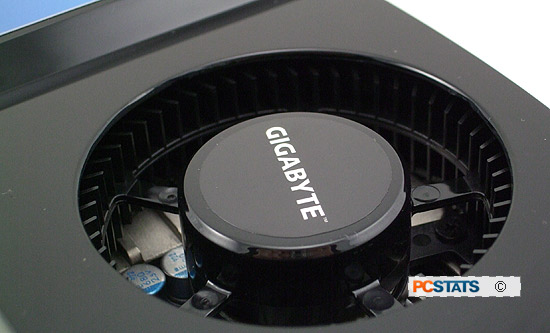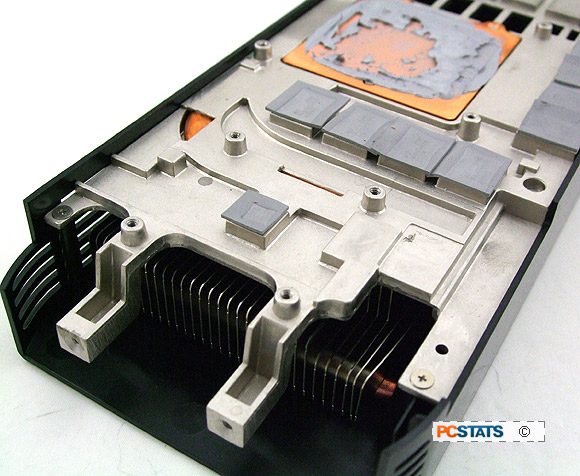Here's how the Gigabyte GV-N260C896H-GA videocard stacks up in real life against a
couple different cards. PCSTATS measures total system power draw and compares
that in 3D loaded (max value recorded in 3DMark06) and idle states (at Windows
desktop). The power supply used in each test is an A-PFC compliant PC Power and Cooling 750W model.
 Videocard Power Consumption (Total System Power Draw) Videocard Power Consumption (Total System Power Draw) |
| Idle at Desktop |
WATTS |
Ranking |
|---|
| Palit HD4870 X2 2GB |
177 |
   |
| Asus EAH3870 X2 1GB TOP/G/3DHTI/1G/A |
153 |
   |
| Asus EAH3870 X2 1GB TOP/G/3DHTI/1G/A (Crossfire) |
222 |
   |
| MSI R3870X2-T2D1G-OC |
165 |
   |
| Asus EAH4890 HTDI/1GD5/A |
137 |
   |
| Asus EAH4850 HTDI/512M |
120 |
   |
| MSI R4830 T2D512-OC (Radeon 4830) |
108 |
   |
| Gigabyte GV-R477D5-512HB |
135 |
   |
| Gigabyte GV-R477D5-512HB Crossfire |
180 |
   |
| Asus EAH4770 HTDI/512MD5/A |
101 |
   |
| Diamond Viper Radeon HD 2900XT CrossFire |
195 |
   |
| Asus EAX1900XTX 2DHTV/512M/A |
160 |
   |
| Asus EAX1950PRO/HTDP/256M/A |
150 |
   |
| ASUS ENGTX260 MT/HTDI/896MD3-A |
135 |
   |
 Gigabyte GV-N26OC896H-GA Gigabyte GV-N26OC896H-GA |
112 |
   |
| Sparkle GTX260 Core 216 |
140 |
   |
| ASUS ENGTS250 DK |
120 |
   |
| ASUS ENGTS250 DK in SLI |
170 |
   |
| Gigabyte GV-N96TSL-1GI |
96 |
   |
| nVidia Geforce 9600GTs in SLI |
166 |
   |
| Asus EN9600GT Top/HTDI/512M |
152 |
   |
| Palit Geforce 9600GT 512 |
151 |
   |
| MSI NX8800GTX-T2D768E |
196 |
   |
| MSI NX7950GX2-T2D1GE |
183 |
   |
| MSI NX7900GTX-T2D512E |
165 |
   |
| Gigabyte GV-NX76T256D-RH |
140 |
   |
| 3D Loaded: |
WATTS |
Ranking |
|---|
| Palit HD4870 X2 2GB |
421 |
   |
| Asus EAH3870 X2 1GB TOP/G/3DHTI/1G/A |
390 |
   |
| Asus EAH3870 X2 1GB TOP/G/3DHTI/1G/A (Crossfire) |
610 |
   |
| MSI R3870X2-T2D1G-OC |
330 |
   |
| Asus EAH4890 HTDI/1GD5/A |
225 |
   |
| Asus EAH4850 HTDI/512M |
202 |
   |
| MSI R4830 T2D512-OC (Radeon 4830) |
177 |
   |
| Gigabyte GV-R477D5-512HB |
186 |
   |
| Gigabyte GV-R477D5-512HB Crossfire |
279 |
   |
| Asus EAH4770 HTDI/512MD5/A |
153 |
   |
| Diamond Viper Radeon HD 2900XT CrossFire |
549 |
   |
| Asus EAX1900XTX 2DHTV/512M/A |
333 |
   |
| Asus EAX1950PRO/HTDP/256M/A |
252 |
   |
| ASUS ENGTX260 MT/HTDI/896MD3-A |
277 |
   |
 Gigabyte GV-N26OC896H-GA Gigabyte GV-N26OC896H-GA |
215 |
   |
| Sparkle GTX260 Core 216 |
262 |
   |
| ASUS ENGTS250 DK |
214 |
   |
| ASUS ENGTS250 DK in SLI |
316 |
   |
| Gigabyte GV-N96TSL-1GI |
160 |
   |
| nVidia Geforce 9600GTs in SLI |
313 |
   |
| Asus EN9600GT Top/HTDI/512M |
220 |
   |
| Palit Geforce 9600GT 512 |
221 |
   |
| MSI NX8800GTX-T2D768E |
345 |
   |
| MSI NX7950GX2-T2D1GE |
315 |
   |
| MSI NX7900GTX-T2D512E |
277 |
   |
| Gigabyte GV-NX76T256D-RH |
213 |
   |
The
computer and videocard industry has done a lot to curb excessive power draw this
generation, and the endless push for smaller die-sizes means that even though
today's videocards are more powerful, they use significantly less electricity.Even though it's been pre-overclocked, the Gigabyte GV-N260C896H-GA videocard wasn't fazed at
all during this power test. It's drawing nearly 50W less than Asus and
Sparkle Geforce GTX260s under load, a stellar result!

The
majority of spikes in the above power draw chart indicate dual videocard SLI or
Crossfire test situations, modern videocards have become a lot more power
efficient thanks largely to die shrinks and optimization. The Gigabyte GV-N260C896H-GA
videocard itself will require two 6-pin auxiliary SLI power connectors, but when stressed
the total power draw doesn't push total system power draw past 300 Watts.
Heat and Noise
Observations
The Gigabyte GV-N260C896H-GA videocard is clad in a very substantial heatsink, hidden behind a black plastic
fan shroud that directs airflow along the cards length. A single squirrel cage fan
draws air in at the back of the card and directs it across the heatsink
before it's exhausted at the I/O side back into the case.

Because
hot air
is vented out through the card's I/O panel out of the PC case, that helps keep
internal case temperatures in check, and hence the videocard can operate with less
noise because the fans aren't running at 100%. Still, it's a good idea to
ensure your PC case has decent airflow to keep overall fan noise down to a low
level... the hotter things get the faster fans need to spin. At full fan speed
the Gigabyte GV-N260C896H-GA doesn't make too much noise, thankfully.

Along with the massive slab of Geforce
GTX260 GPU, the heatsink makes contact with each one of the BGA DRAM modules via small squares of
soft thermal gap filler. Now that you know what's going on inside
the chip and under the heatsink, it's time to see just how far
we can push the Gigabyte GV-N260C896H-GA videocard!
